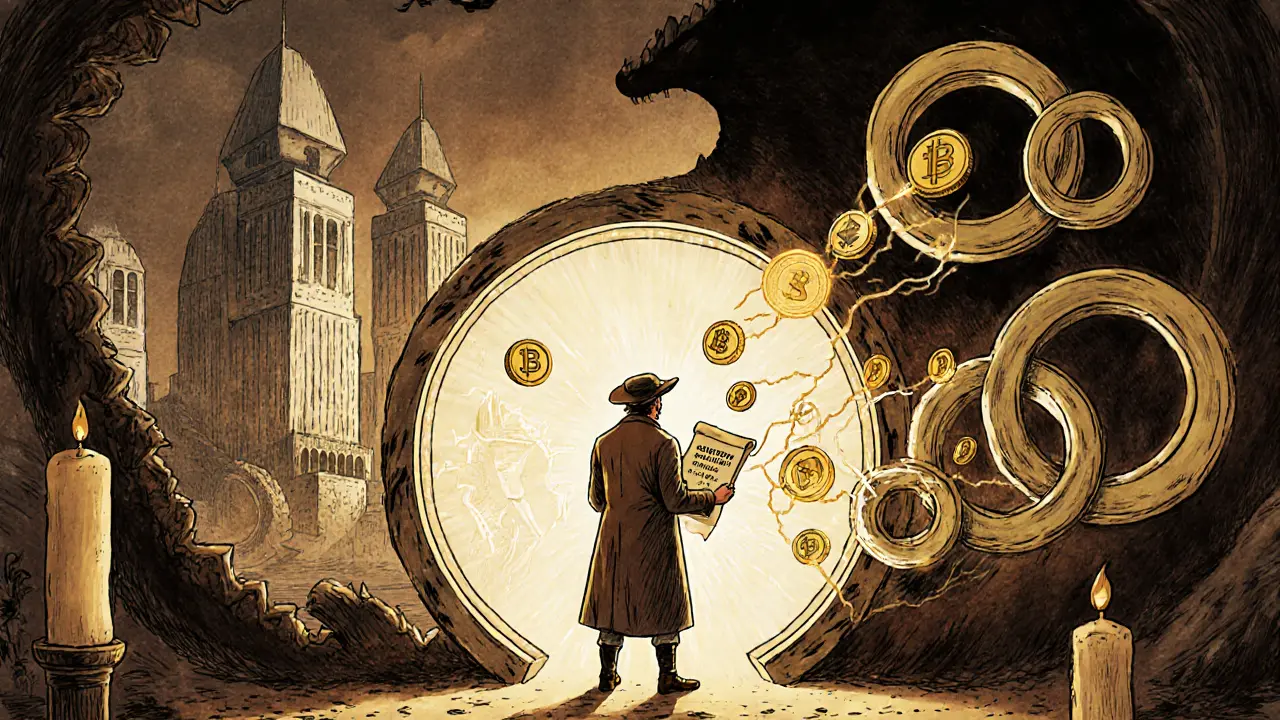Moonbeam vs Ethereum Transaction Cost Calculator
Compare Your Transaction Costs
Calculate how much you'd pay in transaction fees to move assets between Ethereum and Moonbeam. Moonbeam's fees are typically under $0.10 per transaction, compared to Ethereum's $5-$50 range.
Moonbeam (GLMR)
Average fee: $0.05 per transaction
$0.00
Ethereum
Average fee: $25 per transaction
$0.00
Savings Compared to Ethereum
$0.00 in total savings
0% cost reduction
Moonbeam (GLMR) isn’t just another crypto coin. It’s a bridge - one that lets Ethereum apps run smoothly on the Polkadot network without rewriting a single line of code. If you’ve ever tried to move a DeFi app from Ethereum to another chain and hit a wall with incompatible tools, Moonbeam was built to solve that exact problem.
What Exactly Is Moonbeam?
Moonbeam is a smart contract blockchain that’s fully compatible with Ethereum. That means if you’re a developer who knows how to write Solidity contracts, use MetaMask, or deploy with Truffle or Hardhat - you can drop your project onto Moonbeam with almost zero changes. It’s not a Layer 2 solution like Polygon. It’s a standalone Layer 1 blockchain, but it’s designed to feel exactly like Ethereum.
It runs as a parachain on Polkadot, which is a network of interconnected blockchains. Polkadot gives Moonbeam shared security - meaning it doesn’t have to rely on its own small group of validators to stay safe. Instead, it leans on the security of the entire Polkadot relay chain. This makes Moonbeam more secure than many independent blockchains, while still keeping the speed and low fees developers want.
What Is GLMR Used For?
GLMR is the native token of the Moonbeam network. It’s not just a speculative asset - it has real, functional uses:
- Transaction fees: You pay in GLMR to send transactions, deploy smart contracts, or interact with dApps.
- Staking: Users can stake GLMR to help secure the network. Validators and nominators earn rewards in GLMR for keeping the chain running smoothly.
- Governance: GLMR holders vote on upgrades, treasury spending, and protocol changes. The more GLMR you hold, the more voting power you have.
As of September 2025, there are just over 1 billion GLMR in circulation out of a total supply of nearly 1.2 billion. The price was around $0.041, with a market cap of roughly $41 million. That puts it at #599 by market cap - far behind giants like Ethereum or Solana, but still a meaningful player in the cross-chain space.
How Is Moonbeam Different From Ethereum?
On the surface, Moonbeam looks like Ethereum. Same tools. Same language. Same wallet. But underneath, it’s built on Substrate - the same framework that powers Polkadot. This gives it advantages:
- Lower fees: Ethereum mainnet can cost $5-$50 per transaction during peak times. On Moonbeam, it’s often under $0.10.
- Faster blocks: Transactions confirm in under 12 seconds, compared to Ethereum’s 12-15 seconds (and sometimes much longer during congestion).
- Cross-chain access: Moonbeam can talk directly to other Polkadot parachains like Acala or Kusama. You can move assets or data between Moonbeam and, say, a DeFi chain on Polkadot without needing a third-party bridge.
But here’s the trade-off: Moonbeam doesn’t have the same user base or liquidity as Ethereum. You won’t find as many users trading GLMR, and not every DeFi protocol is available. That’s why some investors see it as a long-term bet - not a quick flip.

How Does It Compare to Other EVM Chains?
There are a lot of Ethereum-compatible chains now: Polygon, Avalanche, BSC, Arbitrum. So why choose Moonbeam?
Most of those chains are standalone. They secure themselves. Moonbeam doesn’t. It’s tied to Polkadot’s security model, which is a big deal. If Polkadot stays strong, Moonbeam stays strong. That’s a different kind of safety net.
Here’s how it stacks up:
| Feature | Moonbeam | Polygon | Avalanche |
|---|---|---|---|
| Layer Type | Layer 1 (Parachain) | Layer 2 | Layer 1 |
| Security Source | Polkadot Relay Chain | Own validators | Own validators |
| EVM Compatibility | Full | Full | Full |
| Cross-Chain to Polkadot | Yes | No | No |
| Transaction Fee (avg) | $0.02-$0.08 | $0.01-$0.05 | $0.05-$0.20 |
| Market Cap (Sep 2025) | $41M | $7.2B | $10.1B |
Moonbeam doesn’t win on size. But it wins on integration. If you’re building something that needs to work across multiple blockchains - especially within Polkadot - Moonbeam is the only EVM chain that can do it natively.
Who Uses Moonbeam?
Over 200 live applications are already running on Moonbeam. These aren’t just test projects - they’re real, functioning dApps:
- StellaSwap and Curve Finance - decentralized exchanges with liquidity pools.
- Treasureland and NFTrade - NFT marketplaces where users trade digital art and collectibles.
- Tokeniza - a platform bringing real-world assets like real estate and bonds on-chain.
- N3MUS and Outmine - blockchain-based games with in-world economies.
Developers love it because they don’t have to relearn everything. If you’ve built on Ethereum, you can deploy on Moonbeam in hours, not weeks. The Moonbeam Foundation even offers grants and developer accelerators to help teams get started.

What Are the Risks?
Moonbeam isn’t without its problems. In 2024, its price dropped nearly 30% in a single month. Some users reported issues with bridges connecting to Ethereum - especially during high network traffic. There’s also the risk of being overshadowed by bigger players.
Unlike Ethereum, which has millions of daily users, Moonbeam’s user base is still small. That means less liquidity, wider price swings, and fewer people trading GLMR. If you’re looking for a coin with stable volume and deep markets, this isn’t it.
Also, while Moonbeam is secure because of Polkadot, it’s still a young ecosystem. Bugs happen. Upgrades take time. And if Polkadot itself faces challenges, Moonbeam feels it too.
What’s the Future for GLMR?
Analysts are split. Some see Moonbeam as a hidden gem. Changelly’s 2025 forecast predicts GLMR will trade between $0.03 and $0.04, but by 2030, it could average $0.44 - a tenfold increase. That’s only possible if adoption grows. If more developers start building cross-chain apps, and if Polkadot’s ecosystem expands, Moonbeam could become essential.
Right now, it’s not a coin for traders chasing quick gains. It’s a coin for builders, long-term believers, and people who think the future of crypto isn’t one big blockchain - but many interconnected ones.
If you’re a developer, GLMR gives you a fast, cheap, secure way to deploy Ethereum apps with cross-chain access. If you’re an investor, you’re betting on the idea that interoperability will win - and Moonbeam is one of the few chains built to make that real.
Frequently Asked Questions
Is Moonbeam the same as Ethereum?
No. Moonbeam is an Ethereum-compatible blockchain, meaning it runs the same code and tools as Ethereum, but it’s built on Polkadot’s infrastructure. It’s faster, cheaper, and connected to other blockchains in the Polkadot network - but it’s not the Ethereum mainnet.
Can I use MetaMask with Moonbeam?
Yes. Moonbeam has full Web3 RPC compatibility, so you can add it as a custom network in MetaMask using its RPC endpoint. Once added, you can send and receive GLMR, interact with dApps, and deploy smart contracts just like you would on Ethereum.
How do I get GLMR tokens?
You can buy GLMR on exchanges like Gate.io, KuCoin, and MEXC. You can also earn it by staking through the Moonbeam network or by participating in liquidity mining programs on dApps built on Moonbeam.
Is GLMR a good investment?
It depends on your timeline. Short-term, GLMR is volatile and has seen big price drops. Long-term, if Moonbeam becomes the go-to platform for cross-chain Ethereum apps, GLMR could grow significantly. It’s not a safe bet for beginners - but for those who believe in interoperability, it’s one of the most promising projects in the space.
What’s the difference between Moonbeam and Moonriver?
Moonriver is Moonbeam’s test network on Kusama, Polkadot’s experimental sister chain. Moonriver gets new features first - it’s faster to upgrade but less secure. Moonbeam is the main, more stable version. Developers often test on Moonriver before launching on Moonbeam.
